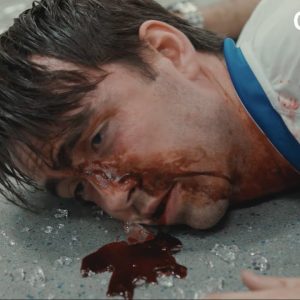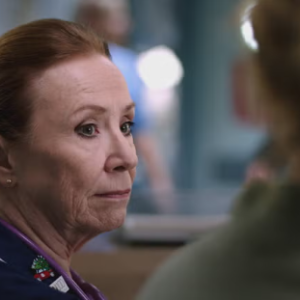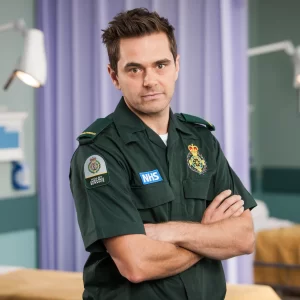Casualty Shockwave: Internal Affairs Investigation Uncovers Alarming Misconduct
The BBC’s long-running medical drama Casualty has once again delivered a tense and hard-hitting storyline — this time delving deep into the murky waters of internal politics, moral compromise, and the devastating consequences of professional misconduct. In the latest episode, aptly titled “Exposing His Misconduct!”, Holby’s Emergency Department becomes the epicenter of a scandal that threatens careers, friendships, and the very integrity of the hospital.
A Case That Starts in the Shadows
The episode wastes no time in setting the tone. We see a tense exchange between two staff members in a dimly lit corridor — voices lowered, glances darting nervously toward approaching footsteps. Something is wrong, and the audience can feel it. Hints of administrative irregularities and questionable patient care decisions begin to surface, leaving viewers with the sinking realization that this is not going to be an ordinary day at Holby.
The focus quickly turns to the arrival of the Internal Affairs Unit, led by a no-nonsense investigator whose sharp eye misses nothing. Her presence sends ripples of anxiety through the staff, especially those who have secrets to hide. The camera lingers on several familiar faces, each revealing a mix of apprehension and guilt.
The Accusations: More Than Just Office Gossip
While Casualty is no stranger to tense interpersonal drama, this storyline feels particularly raw. The allegations range from falsified patient records to questionable procurement practices — the kind of behind-the-scenes misconduct that can ruin reputations and put lives at risk. It’s not just a matter of professional pride; it’s about public trust in the NHS.
The suspected staff member, initially portrayed as confident and untouchable, slowly unravels under the scrutiny of the investigation. His deflections and carefully worded statements only deepen the suspicions. But what makes this episode gripping is how it forces the audience to question — is he truly guilty, or has he been set up by someone with their own agenda?
Personal Stakes and Collateral Damage
As the investigation intensifies, Casualty explores the ripple effect of such allegations. Junior staff find themselves caught between loyalty and duty, friends become reluctant witnesses, and patients start to question whether they are receiving safe care. One particularly moving subplot follows a long-time patient who overhears fragments of the ongoing investigation and begins to fear that their own treatment has been compromised.
For the accused, the pressure is overwhelming. His family becomes collateral damage as gossip spreads beyond hospital walls. We see emotional breakdowns behind closed doors, heated arguments in staff rooms, and whispered conversations cut short when investigators approach.
The Turning Point: A Critical Piece of Evidence
Just when it seems the investigation may be stalling, a breakthrough comes from an unexpected source — a junior nurse who has been wrestling with a guilty conscience. In a tense scene, she hands over a piece of evidence that could make or break the case. The moral complexity is palpable: she knows that speaking up might cost her relationships with colleagues, but remaining silent could endanger patients.
The evidence, once examined, confirms the worst fears of Internal Affairs. It’s a damning revelation, implicating the accused in a chain of decisions that directly violated hospital protocol and endangered patient safety.
Confrontation and Consequences

The climax of the episode comes when the accused is confronted with the evidence in a closed-door meeting. The dialogue is razor-sharp, filled with denials, half-admissions, and flashes of anger. Ultimately, the truth comes out in a quiet, broken confession — not the dramatic outburst some might expect, but a subdued acknowledgement of guilt that somehow feels even more devastating.
The hospital administration wastes no time in taking action. Suspension is immediate, pending formal hearings. The episode closes with a haunting image: the accused walking out of Holby ED for what may be the last time, head lowered, colleagues watching in silence.
A Mirror to Real-World Issues
While fictional, Casualty’s portrayal of internal misconduct and the role of oversight bodies resonates with real-world healthcare challenges. In an era where public trust in institutions can be fragile, the episode underscores the importance of transparency, accountability, and the courage of whistleblowers.
By weaving personal drama with systemic issues, the writers ensure that the storyline is not only compelling television but also a conversation starter about the pressures and ethical dilemmas faced by medical professionals.
Fan Reactions: Social Media Erupts
Within minutes of the episode airing, social media lit up with reactions. Fans praised the show’s willingness to tackle serious and uncomfortable subjects. Some expressed shock at the character’s downfall, while others commended the performance of the cast — particularly the actor portraying the investigator, whose calm but relentless pursuit of the truth drew comparisons to real-life investigative figures.
One trending post read:
“Casualty at its best — gripping, emotional, and painfully real. That final scene will stay with me for a long time.”
Another fan commented:
“The Internal Affairs storyline has me on edge. This is why I keep coming back to Holby every week.”
Looking Ahead
With the misconduct exposed, the question now shifts to how Holby ED will recover from the scandal. Will the remaining staff be able to rebuild trust among themselves and with patients? Could the investigation uncover deeper systemic problems? And most intriguingly, is this truly the end of the road for the disgraced character, or will Casualty find a way to explore his redemption arc in future episodes?
One thing is certain: the fallout from this storyline will continue to shape the hospital’s dynamics for weeks to come. For long-time viewers, it’s a reminder that Casualty is as much about the people behind the scrubs as it is about the patients they treat — and that sometimes, the most dangerous wounds are the ones you can’t see on an X-ray.





